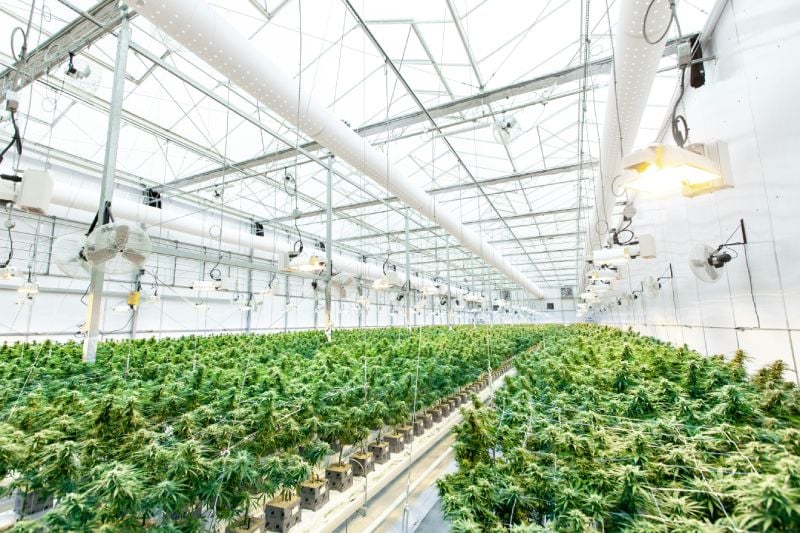Top 5 Greenhouse Climate Control Solutions for Year-Round Farming
)
Although greenhouses offer a great setting for producing crops all year round, they might become unreliable or ineffective if the right climate control systems aren't installed. Regardless of the outside weather, a well-maintained greenhouse climate guarantees that plants receive the ideal temperature, humidity, and air quality for healthy growth
The top five greenhouse temperature control strategies which will assist you in maintaining the perfect growth conditions, raising crop yields, and managing your greenhouse more effectively.
Why Climate Control is Crucial for Greenhouses
It's critical to first comprehend the significance of greenhouse gas climate regulation. Yields from traditional farming are uneven because of the weather's unpredictability. Growers may produce a stable environment in a greenhouse, though, by installing the right climate control systems. This makes it possible to have consistent plant development and quality, which is crucial for commercial agriculture.
Climate control systems maximize a number of important factors:
Temperature: Plants have specific temperature ranges for optimal growth. Overheating or freezing can stunt growth or even kill crops.
Humidity: The right humidity level prevents plants from losing water too quickly or developing fungal diseases.
Ventilation: Fresh air reduces humidity and removes harmful gases like carbon dioxide.
Lighting: Controlling light exposure ensures plants receive enough energy for photosynthesis.
Without climate control, greenhouses can become vulnerable to overheating, plant stress, or reduced yields.
Now, let's explore the top five climate control solutions that make year-round farming possible.
1. Heating Systems
Maintaining the right temperature in a greenhouse, especially during colder months, is essential. Heating systems come in various forms, including:
Hot Water Systems: These use boilers to heat water and pump it through pipes to warm the air. They are energy-efficient and provide even heat distribution.
Gas Heaters: These are standalone units that generate heat by burning natural gas or propane. They are effective but may require proper ventilation to prevent the buildup of harmful gases.
Electric Heaters: Electric systems are easy to install and maintain but can be expensive to operate, especially in large greenhouses.
Think about your budget, the temperature in your area, and the size of your greenhouse when selecting a heating system. Winter farming is viable if you have an efficient heating system that lets you extend your growing season.
Heating System Benefits:
Prevents crop damage during cold weather
Provides consistent growth conditions in colder months
Extends the growing season for year-round farming
2. Cooling Systems
Conversely, in warmer climates or during hotter months, cooling systems are important. Greenhouses can easily become overheated without sufficient cooling, which can stress plants and cause dehydration.
Evaporative Cooling Systems: A cooling effect results from the temperature dropping when water evaporates. Evaporative coolers are a common option for greenhouses since they are economical and energy-efficient.
Shade Cloths: Shade cloths block off a portion of the greenhouse's solar radiation. They are available in various shade percentages so you may adjust the amount of light that is filtered.
Mechanical Ventilation: Cool, outside air can be drawn in and hot air can be ejected using exhaust fans and roof vents. The ideal temperature may be effectively maintained with this natural ventilation system.
Cooling systems can be automated for efficiency and help avoid stress on plants during the hours of maximum sunlight. Evaporative cooling or shade in conjunction with ventilation can help keep the atmosphere comfortable for both workers and plants.
Cooling System Benefits:
Protects crops from overheating
Maintains optimal temperature during hot weather
Reduces water loss in plants
3. Humidity Control Systems
Retaining the proper humidity levels is essential to avoiding rot, mould, and mildew. In order to maintain healthy plants, humidity management systems make sure the air within the greenhouse is neither too dry nor too wet.
Fogging Systems: To raise humidity levels, fogging systems spray a light mist into the atmosphere. These devices can in handy during hot, dry weather or in arid areas. They are also advantageous for some crops that do well in high relative humidity.
Dehumidifiers: These are great for crops that need drier conditions or in places where there is an abundance of moisture. They keep the air's moisture content at just the right amounts to support plant growth.
Automated Climate Control Systems: With the help of modern technology, humidity may be monitored and adjusted in real time. A control system receives data from sensors positioned all over the greenhouse and uses it to automatically change the ventilation, dehumidification, or humidifier systems to maintain the right levels.
Growers can minimize crop quality and prevent common plant illnesses by efficiently controlling humidity.
Humidity Control System Benefits:
Reduces the risk of fungal diseases
Ensures optimal moisture levels for different plant types
Automates climate adjustments for efficiency
4. Ventilation and Airflow Systems
Enough air movement is essential to preserving a greenhouse's perfect climate. In order to guarantee that fresh air is constantly replacing stale air and that air is distributed evenly, ventilation and airflow systems collaborate with heating and cooling systems.
Exhaust Fans: Exhaust fans aid in bringing in cooler, fresher air by drawing out hot, stagnant air. These systems may be set to activate when the temperature reaches a predetermined point, which makes them indispensable in the warmer months.
Roof and Side Vents: The greenhouse's sides and roof are equipped with automated or manual vents that facilitate natural air circulation. Cooler air is pulled in through lower vents and hot air exits through the vents as it rises.
Circulation Fans: By distributing air uniformly across the greenhouse, these fans aid in avoiding hot areas and preserving steady temperatures.
Proper ventilation removes excess heat and humidity from the air while ensuring that plants receive the fresh air they require for respiration.
Ventilation System Benefits:
Promotes healthy airflow, reducing plant stress
Helps manage temperature and humidity levels
Prevents stagnant air, reducing the risk of pests and diseases
5. Integrated Environmental Control Systems
Integrated environmental control systems incorporate humidity, ventilation, heating, cooling, and lighting into a single automated system for the best possible climate management. In order to maintain the ideal growing environment for plants, these systems continuously monitor and alter all significant environmental parameters.
Sensors and Monitoring: To measure temperature, humidity, CO2 levels, and light intensity, these systems make use of cutting-edge sensors. A central control unit receives data and uses it to activate the necessary systems to change the environment.
Automation: Growers can utilize automation to set precise conditions for various greenhouse zones. For instance, a certain area can need higher humidity or colder temps than another. Each zone's ideal growing conditions are maintained for its particular crops thanks to automation.
Remote Access: Growers may monitor and modify conditions even when they are off-site thanks to the remote access features that many contemporary integrated control systems provide via computers or smartphones.
Greenhouse operators may establish highly efficient and consistent growing environments that result in higher yields and lower energy costs by investing in integrated environmental control.
Integrated Environmental Control Benefits:
Maximizes efficiency with automated adjustments
Allows for precise control over multiple environmental factors
Saves time and reduces manual intervention
Provides real-time data and remote monitoring capabilities
At Cultivate & Equipment we understand that climate control is crucial for greenhouse growers to keep a steady environment that allows for year-round production. These top five temperature control options will assist you in creating the ideal atmosphere for your crops, regardless of whether your goal is to heat during the winter or cool during the summer.
The correct systems mix (heating, cooling, humidity management, ventilation, and integrated control) will enable you to maximize yields, maintain healthy plant development, and operate your greenhouse more effectively.
Consider carefully what your greenhouse will require in terms of crops, climate, and cost. Regardless of the outside weather, your greenhouse can flourish all year long and produce reliable, high-quality crops with the correct climate control techniques.
As technology advances, greenhouse climate control systems continue to evolve, offering more efficient and sustainable solutions. Stay informed about new developments to ensure that your greenhouse remains at the cutting edge of farming innovation. Contact the experts at Cultivate & Equipment today for your greenhouse project.
| Tags:GreenhouseLatest News |

